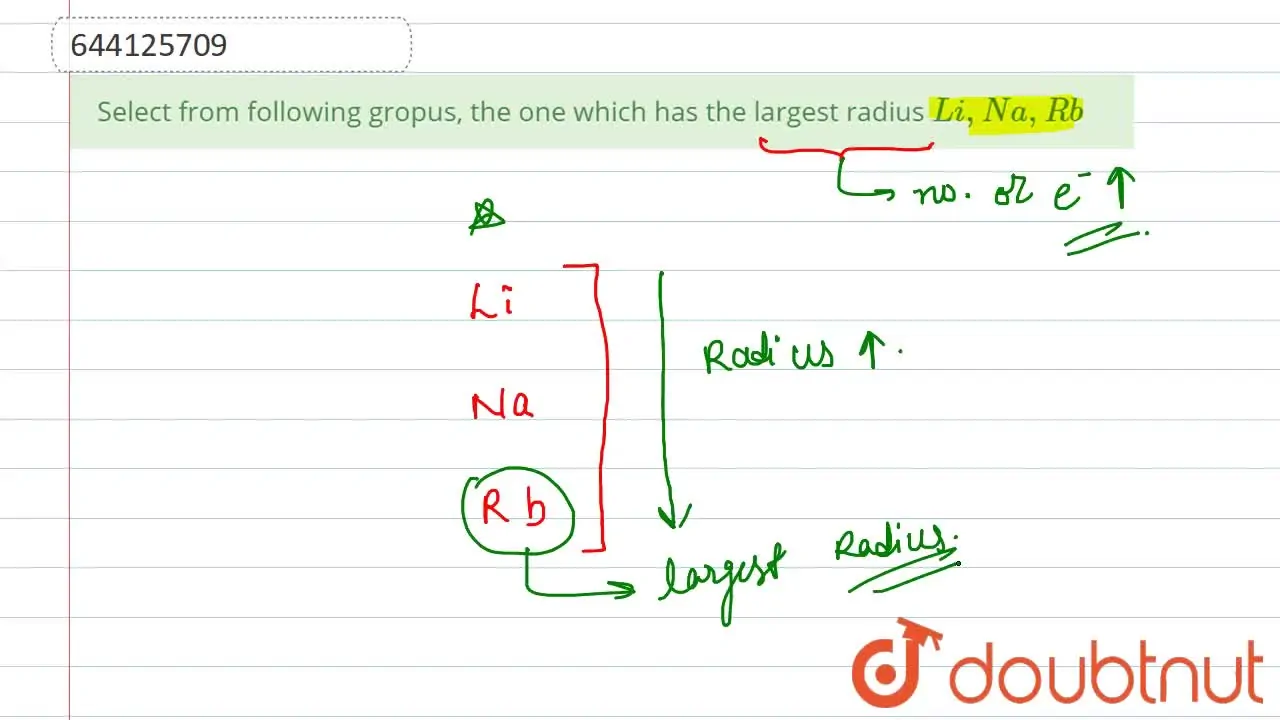Select from following gropus, the one which has the largest radius Li,Na,Rb
Co (The others have the same nuclear charge, but less electrons)
(ii) S2− (All have the same electronic configuration, but the S nucleus has the smallest positive charge)
(iii) Rb (It is in the largest period)
(iv) C (It is the farthest left in the periodic table)
(v) na(It is the first element of a new period)
(vi) La(Lu is smaller because of lanthaniod contraction)
(vii) Au (Ag is almost the same size, because of the effect of the lanthanoid contraction on Au)
(viii) Ba(HF is much smaller because of the effect of the lanthanoid contraction)
(ix) na(The size decreases along the period (→) and also as electrons are removed)
(b) Less (IE decreases down the group (⏐↓) due to increasing atomic size, but other factors also play an important role) The observed value is 8.1 eV
(c) It is difficult to remove e− from P than from S because of the added stability of the half- filled p-subshell The observed value is 10.9eV
(d) The IE of Na should be intermediate between that of Li and K The IE of Na should be close to the arithmatic average of the two, or 4.9eV The observed is 5.1eV
(e) Generally IE increases along the period (→) However there is a larger increase in IE from Li(Z=3) to Be (Z=4) than from Be to C(Z=6) IE of B actually is less than that of Be due to penetration effect in B The observed IE of B is 8.3eV N has a half -filled 2p subshell and should have extra stability for this reason The increase in going from N(Z=5) to (Z=6) is 3.0eV and the additional increase should be greater than this, thus the IE of N should exceed 14.3eV The experimental value is 14.5eV
(f) Sr (It is a metal)
(g) (i) CI (All of them belong to 3rd period and CI is farthest to the right of the three elements)
(ii) He (iii) Ne
(h) (i) K>Rb>Cs (Generally IE decreases down the group (⏐↓))
(ii) C>Be>B (The 2se− is more difficult to remove than 2p (penetration effect)
(iii) Au>Cu>Ag (The lanthanoid contraction makes Ag and Au about equal in size but Au has a much greater nuclear charge)
(iv) N>O>C (Due to stability of half- filledorbitals)
(v) F>N>O (The half- filed p-subshell of N imparts enough extra stability to make its IE>IE of O)
(vi) Sc>Ca>K (In each of these cases, a 4se− is being removed and the order is as shown)
(vii) Mg>AI>Na (It is more difficult to remove an e− from Mg because the e− being removed is a 3s e− from a filled subshell The 3pe− of AI is easily removed It is easiest to remove an e− from na because of its large size)
(viii) Fe3+>Fe2+>Fe (All have same nuclear charge and the number of e−'s increases in the order listed) (ix) K⊕>Ar>CIΘ (All have the same electronic configuration and the nuclear chared decreases in the order listed)
(i) Cu(Z=29)⇒3d104s1,Cu⊕=3d104s∘
Cu+2=3d94s∘
(ii) K(Z=19)⇒4s1,K⊕=4s∘,k+2=3p5
Cu has 10 more protons and more e−'s than does K but due to imperfect screening effect of de−'s,IE1 of Cu>IE1 of K and IE2 for K involves the removal of an e− from an octet (3s23p6) whereas that of Cu involves the more easily ionised d10 configuration Hence IE2 of K>IE2 of Cu
(j) K⊕ loses an e− from its 3p6 subhell, Ca⊕ from its 4s subshhell, which requires less energey
Hence IE(2) of K⊕>IE2 of Ca⊕
(ii) Zn(Z=30)⇒3d104s2,Zn⊕⇒3d104s1
Cu(Z=29)⇒3d104s1,Cu⊕⇒3d104s∘
Zn⊕ loses an e− from 4s1 more easily than Cu⊕ loses an e− from 3d10
Hence IE2 of Cu⊕>IE2 of Zn⊕
(k) The IE of an e− in eV is numerically equal to IP in volts
Note If a particle being accelerated by a potential has a charge equal in magnitude to the charge on an e− the number of eV of energy is numerically equal to the potential in valts (V) .
Related Playlists
- BOOK - CENGAGE CHEMISTRY ENGLISHCHAPTER - CHEMICAL BONDING AND MOLECULAR STRUCTUREEXERCISE - Ex 2 .2 Subjective (Intermolecular Forces And H-Bonding)7videos
CHEMICAL BONDING AND MOLECULAR STRUCTURE
- BOOK - CENGAGE CHEMISTRY ENGLISHCHAPTER - CHEMICAL BONDING AND MOLECULAR STRUCTUREEXERCISE - Ex 2 .2 Subjective (Molecular Orbital Theory)4videos
CHEMICAL BONDING AND MOLECULAR STRUCTURE
- BOOK - CENGAGE CHEMISTRY ENGLISHCHAPTER - CHEMICAL BONDING AND MOLECULAR STRUCTUREEXERCISE - Archives Subjective15videos
CHEMICAL BONDING AND MOLECULAR STRUCTURE
- BOOK - CENGAGE CHEMISTRY ENGLISHCHAPTER - ATOMIC STRUCTUREEXERCISE - Concept Applicationexercise(4.3)19videos
ATOMIC STRUCTURE
- BOOK - CENGAGE CHEMISTRY ENGLISHCHAPTER - CHEMICAL EQUILIBRIUMEXERCISE - Subjective type1videos
CHEMICAL EQUILIBRIUM
Similar Questions
Which ion has the largest radius ?
View SolutionWhich of the following has largest radius?
View SolutionWhich of the following has the largest ionic radius ?
View SolutionWhich one of the following has the largest atomic radius?
View SolutionFrom the electronic configurations Na (2, 8, 1), Mg (2, 8, 2) and Al (2, 8, 3), answer the following questions:
Which element has the largest atomic radius?View SolutionFrom the electronic configurations N (2,5), O (2,6) and F (2,7), answer the following questions:
Which one has the largest atomic radius?View SolutionWhich of the following expression has the largest value?
View SolutionWhich out of the following has the largest size ?
View SolutionWhich of the following species has the largest bond angle?
View SolutionOf the following lists of numbers , which has the largest standard deviation ?
View Solution


